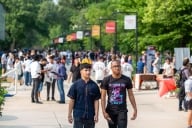You have /5 articles left.
Sign up for a free account or log in.
Ann Henderson hopes five wall-mounted touch screens change a culture in which many young Floridians never cast a ballot and political debate is tinged with condescension and disrespect.
Henderson, director of the University of Florida’s Bob Graham Center for Public Service, launched the Civil Debate Wall this month. Florida students and other Floridians ages 18-29 are encouraged to answer questions like “Is Occupy Wall Street the civil rights movement of our time?” and “Is wealth distributed fairly in the United States?”
Here’s how it works: Someone at the Gainesville campus' Pugh Hall goes up to one of the screens and replies either to another commenter’s post or the Wall’s current topic. A wall-mounted camera then takes a picture and posts the comment along with the person’s first name. Commenters can also log in through Facebook, and Henderson hopes to have a mobile app functioning in the next month. In time, she wants to connect all of Florida’s public universities with the Wall. (Though there are Facebook and Twitter pages for it, they don't post real-time reactions.)
The goal is for young people to become more civically active while eschewing a tendency toward partisan nastiness.
So far, the results are promising. When the Civil Debate Wall asked whether the U.S. should be giving foreign aid during a domestic financial crisis, opinions were split. “You had people who thought we should never give foreign aid and people who said we are the leaders of the free world and we should always be generous,” Henderson said. “And we had the middle people, who said we should give aid in a time of humanitarian crisis.”
It was in finding that common ground – where most critics of foreign assistance agreed recovery money after Haiti’s earthquake or Japan’s tsunami was well-spent – that the Wall proved its worth, Henderson said.
“We’re trying to say you can disagree with somebody, you can do it civilly, you can do it with respect,” she said.
That’s especially important, she said, at a time when political issues are polarizing and debate can be bitter. “At the end of the day, it’s not just about being polite,” Henderson said, “it’s about how to function in a democracy when you believe that and I believe this.”
The Civil Debate Wall started when Henderson and interactive media designer Jake Barton spoke about another project. They both agreed civil debate was sorely lacking among young people in Florida and beyond, and thought the Graham Center was a natural place to promote it.
That eventually led to a $3 million grant from the John S. and James L. Knight Foundation, which allowed Barton – who also created interactive programs for the National September 11 Memorial and Museum – to start on the project. The Wall first got off the ground 18 months ago as a video projector, but the new five-screen setup was unveiled in Gainesville last week. While old responses were deleted in the software transition, new posts can be monitored at civildebatewall.com.
Everyone has behaved so far, despite opinions that run the political gamut. That, Henderson said, is what the Wall is all about. “Can we train ourselves to say, ‘I don’t agree with you on most of what you say, but here’s an area where we agree?’ ” Henderson said. “We think this is a crisis in civil debate and an ability to provide compromise.”







